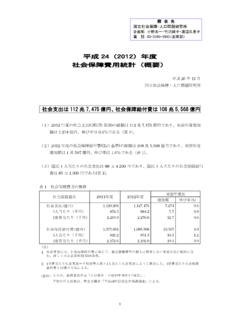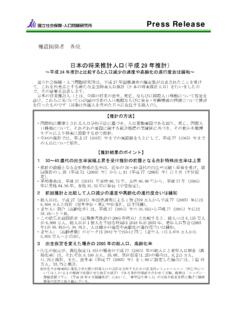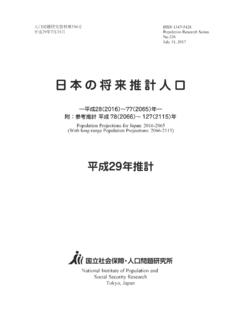Transcription of Population Projections for Japan (January 2012): 2011 to 2060
1 Population Projections for Japan (January 2012 ): 2011 to 2060 Appendix: Auxiliary Projections 2061 to 2110 I Introduction II Summary of Population Trends A. The Results of Projections According to the Three Fertility Variants with Medium-Mortality Assumption 1. Population Size and Growth 2. Population Age Composition 3. Age Dependency Ratio 4. Changes in the Population Pyramid B. The Results of Projections According to the Medium-Fertility Assumption with High- and Low-Mortality Assumptions 1. Summary of the Results of projection with High-Mortality Assumption 2. Summary of the Results of projection with Low-Mortality Assumption C.
2 The Results of Projections According to the High- and Low-fertility Assumptions with High- and Low-Mortality Assumptions III Summary of the Method Used for Population Projections 1. Jump-off Population 2. Assumptions for Fertility Rates and Sex Ratio at Birth 3. Assumptions for Survival Rates (Future Life Table) 4. Assumptions for the International Migration Rate (Numbers) IV Auxiliary Projections V Summary Tables and Figures A. Summary of Results and Assumptions B. Results of Projections According to the Three Fertility Variants with Medium-Mortality Assumption C. Results of Projections According to the Medium-Fertility Assumption with High- and Low-Mortality Assumptions D.
3 Comparison of projection Variants E. Assumption Values F. Results of Auxiliary Projections National Institute of Population and Social Security Research in Japan 1 Population Projections for Japan (January 2012 ) Based on the latest results from the Population Census of Japan and the Vital Statistics of Japan , the National Institute of Population and Social Security Research in Japan (IPSS) has conducted a new national Population projection exercise ( Population Projections for Japan ). This is the 14th release of national Population Projections by the Institute, including the period before the integration between the Institute of Population Problems and the Social Development Research Institute.
4 I Introduction The Population Projections for Japan project the size and structure of the Population into the future based on assumptions on future fertility, mortality, and international migration levels. Given that future changes in fertility, mortality and international migration cannot be known with certainty, the IPSS Projections provide a well-defined range of likely future Population developments by computing variants based on alternative scenarios. The Projections cover the total Population living in Japan , including non-Japanese residents. This is the same framework as used by the Population Census of Japan .
5 The period of Projections begins with the 2010 Population Census and continues until 2060, projecting the Population as of October 1 for each year. Note that we additionally extended the Population calculations up to 2110 and added these as auxiliary Projections . The method of projection is as follows: we set assumptions on individual components of the Population dynamics, , birth, death, and international migration, by sex and age, and projected the Population demographic trends by sex and age into the future using the cohort component method. Assumptions are made based on actual statistics for each component using the demographic method.
6 (For further details, refer to section III Summary of the Method Used for Population Projections . ) II Summary of Population Trends The Population projection for Japan is based on three alternative assumptions about future changes in both fertility and mortality (a low variant, a medium variant, and a high variant of each), resulting in a total of nine Projections one for each combination of these variants. Hereafter, the outline of the results of the three Projections combining the three assumptions on fertility with the medium-variant assumption for mortality will be presented first, followed by an outline of the results of the three assumptions of fertility combined with the high- and low-mortality assumptions.
7 In the following descriptions, each projection is referred to by the combination of its respective fertility and mortality assumptions, medium-fertility (medium-mortality) projection . A. The Results of Projections According to the Three Fertility Variants with Medium-Mortality Assumption 1. Population Size and Growth According to the 2010 Population Census, which serves as the base year of these Projections , the total Population of Japan in that year was million (total Population including non-Japanese residents). 2 Based on the results of the medium-fertility projection , Japan is expected to enter a long period of Population decline.
8 The Population is expected to decrease to around million by 2030, fall below 100 million to million in 2048, and drop to million by 2060 (see Table 1-1 and Figure 1-1). Based on the results of the high-fertility projection , the total Population is expected to drop below the 100 million mark by 2054 to million, and to decrease further to million in 2060 (see Table 1- 2 and Figure 1-1). Conversely, based on the low-fertility projection , the total Population is expected to fall below 100 million in 2044 and to decline to million by 2060 (see Table 1-3 and Figure 1-1).
9 The range (difference between high and low variant) of the projected total Population size by 2060 is thus equal to million. 2. Population Age Composition (1) Trends in the Young-age Population under 15 and its Share of the Population The annual number of births in Japan (Japanese) has declined from million in 1973 to million in 2010. Consequently, the Population of children under the age of 15 (young-age Population ) has also decreased from 27 million in the early 1980s to million, as recorded in the 2010 Population Census. According to the medium-fertility projection , the Population size of this age group will fall to 15 million mark in 2015 (see Table 1-1 and Figure 1-3).
10 The decline will continue, and the Population of this age group is expected to fall below 10 million in 2046, eventually decreasing to around million by 2060. Looking at the different trends of the number of children in the high- and low-fertility Projections , this age group is expected to be on the decline even in the high-fertility projection and will reach million in 2060 (see Table 1-2). The low-fertility projection leads to a more rapid decline in the size of this age group; it is projected that this demographic group will shrink below 10 million in 2030, and eventually decrease to as little as million by 2060 (see Table 1-3).









